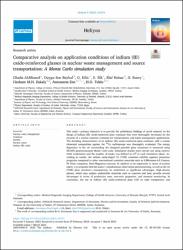| dc.contributor.author | Almisned, Ghada | |
| dc.contributor.author | Şen Baykal, Duygu | |
| dc.contributor.author | Kılıç, Gökhan | |
| dc.contributor.author | Ilık, Erkan | |
| dc.contributor.author | Elaf, Rabaa | |
| dc.contributor.author | Susoy, Gülfem | |
| dc.contributor.author | Zakaly, Hesham M. H. | |
| dc.contributor.author | Ene, Antoaneta | |
| dc.contributor.author | Tekin, Hüseyin Ozan | |
| dc.date.accessioned | 2023-10-19T13:11:38Z | |
| dc.date.available | 2023-10-19T13:11:38Z | |
| dc.date.issued | 2023 | en_US |
| dc.identifier.citation | ALmisned, G; Baykal, DS; Kılıç, G; Ilık, E; Rabaa, E; Susoy, G; Zakaly, HMH; Ene, A; Tekin, HO. Comparative analysis on application conditions of indium (III) oxide-reinforced glasses in nuclear waste management and source transportation: A Monte Carlo simulation study. Heliyon (2023). 9(3). | en_US |
| dc.identifier.issn | 2405-8440 | |
| dc.identifier.uri | https://www.sciencedirect.com/science/article/pii/S2405844023014810?via%3Dihub | |
| dc.identifier.uri | https://doi.org/10.1016/j.heliyon.2023.e14274 | |
| dc.identifier.uri | https://hdl.handle.net/20.500.12780/635 | |
| dc.description.abstract | This study's primary objective is to provide the preliminary findings of novel research on the design of Indium (III) oxide-reinforced glass container that were thoroughly developed for the purpose of a nuclear material container for transportation and waste management applications. The shielding characteristics of an Indium (III) oxide-reinforced glass container with a certain elemental composition against the 60Co radioisotope was thoroughly evaluated. The energy deposition in the air surrounding the designed portable glass containers is measured using MCNPX general-purpose Monte Carlo code. Simulation studies were carried out using Lenovo-P620 workstation and the number of tracks was defined as 108 in each simulation phase. According to results, the indium oxide-doped C6 (TZI8) container exhibits superior protective properties compared to other conventional container materials such as 0.5Bitumen-0.5 Cement, Pb Glass composite, Steel-Magnetite concrete. In addition to its superiority in terms of nuclear safety, it is proposed that the source's simultaneous observation and monitoring, as well as the C6 (TZI8) glass structure's transparency, be underlined as significant advantages. High-density glasses, which may replace undesirable materials such as concrete and lead, provide several advantages in terms of production ease, non-toxic properties, and resource monitoring. In conclusion, the use of Indium (III) oxide-reinforced glass with its high transparency and outstanding protection properties may be a substantial choice in places where concrete is required to ensure the safety of nuclear materials. | en_US |
| dc.language.iso | eng | en_US |
| dc.publisher | Elsevier | en_US |
| dc.relation.isversionof | 10.1016/j.heliyon.2023.e14274 | en_US |
| dc.rights | info:eu-repo/semantics/openAccess | en_US |
| dc.subject | Nuclear waste management | en_US |
| dc.subject | Container | en_US |
| dc.subject | MCNPX | en_US |
| dc.subject | Nuclear safety | en_US |
| dc.subject | Indium (III) oxide | en_US |
| dc.title | Comparative analysis on application conditions of indium (III) oxide-reinforced glasses in nuclear waste management and source transportation: A Monte Carlo simulation study | en_US |
| dc.type | article | en_US |
| dc.contributor.department | İstanbul Kent Üniversitesi, Fakülteler, Sağlık Bilimleri Fakültesi, Fizyoterapi ve Rehabilitasyon Bölümü | en_US |
| dc.contributor.authorID | https://orcid.org/0000-0001-9833-9392 | en_US |
| dc.contributor.institutionauthor | Şen Baykal, Duygu | |
| dc.identifier.volume | 9 | en_US |
| dc.identifier.issue | 3 | en_US |
| dc.relation.journal | Heliyon | en_US |
| dc.relation.publicationcategory | Makale - Uluslararası Hakemli Dergi - Kurum Öğretim Elemanı | en_US |


















